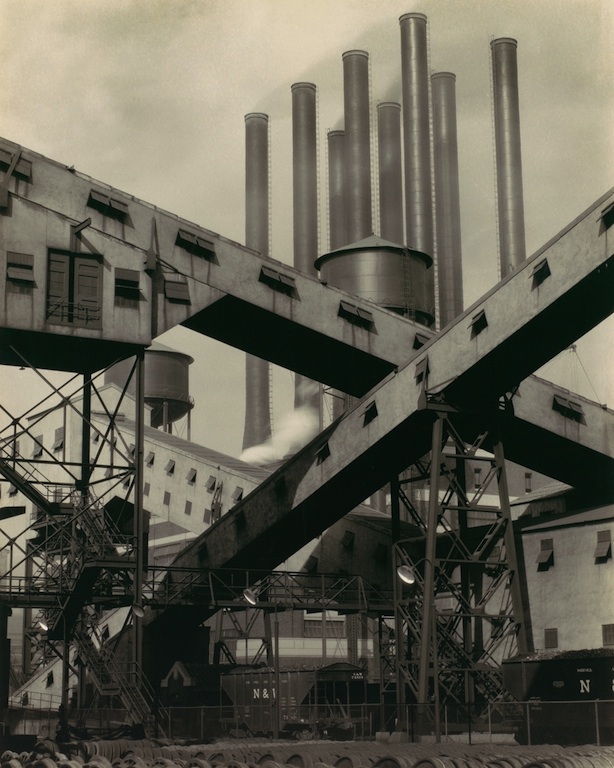
Criss-Crossed Conveyors, River Rouge Plant, Ford Motor Company by Charles Sheeler, 1927
Charles Sheeler’s Criss-Crossed Conveyors, taken at the Ford motor plant at River Rouge, a few miles from Detroit, is one of the landmark photographs of the machine age. In the harshness of industrial construction, the photographer finds an exhilarating new vision of beauty. The play of light on the angular structures defines their forms with absolute precision. The photograph is almost Cubist in its density of overlapping planes, and yet the chaos of steel gantries, smokestacks, water towers, and enclosed conveyors for coke and coal resolves into a state of perfect equilibrium.
Sheeler (1883-1965) is one of the great documentarians of American industry—in both photographs and paintings—and it was easy to take his pictures as unqualified celebrations. Portrayed in this manner, the magisterial immensity of these buildings can provoke quasi-devotional feelings of awe. Sheeler’s factory complex is braced by a mighty cross. Now that so many people have drifted away from organized religion, he observed, “some form other than the Gothic cathedral must be found . . . our factories are our substitute for religious expression.” In 1949, a writer in the New York Daily Worker noted wryly that Sheeler treated the industrial landscape, “with the same sort of piety Fra Angelico used toward angels.”
Construction of the Rouge, a site able to handle every aspect of production, from smelting to assembly, began in 1917. A decade later, the advertising agency N.W. Ayer & Son commissioned Sheeler to make visual interpretations of the vast complex, capable of rolling out 4,000 vehicles a day, as part of the promotional campaign for the new Model A automobile. He spent six weeks on site producing thirty-two official photographs, which he also published independently. In 1928, Criss-Crossed Conveyors appeared in the February 1 issue of Vanity Fair with the title, “By Their Works Ye Shall Know Them”—a biblical allusion. The image replaced a portrait of Henry Ford, which would normally have been used. The magazine shamelessly deified the tycoon as a “present-day Colossus of Business, an almost divine Master-Mind.”
Any view of Sheeler’s masterpiece is now tinged by our knowledge of the history of the automobile industry, by later environmental concerns, and by an awareness of the uncaring way that Fordism treated the human cogs on the assembly line. A workforce of more than 100,000 would eventually labor at the plant, though no workers appear in the picture, and that absence may not be incidental. As Karen Lucic writes in her study Charles Sheeler and the Cult of the Machine, “The images reveal that the price of American industry’s ‘efficient’ organization of production is an oppressive, dehumanized technocracy.” Commercial culture eclipsed religion, but it could never be a substitute. Sheeler’s still sublime image is suffused with an air of foreboding.
See all Exposure columns


Comments [1]
04.01.16
05:23